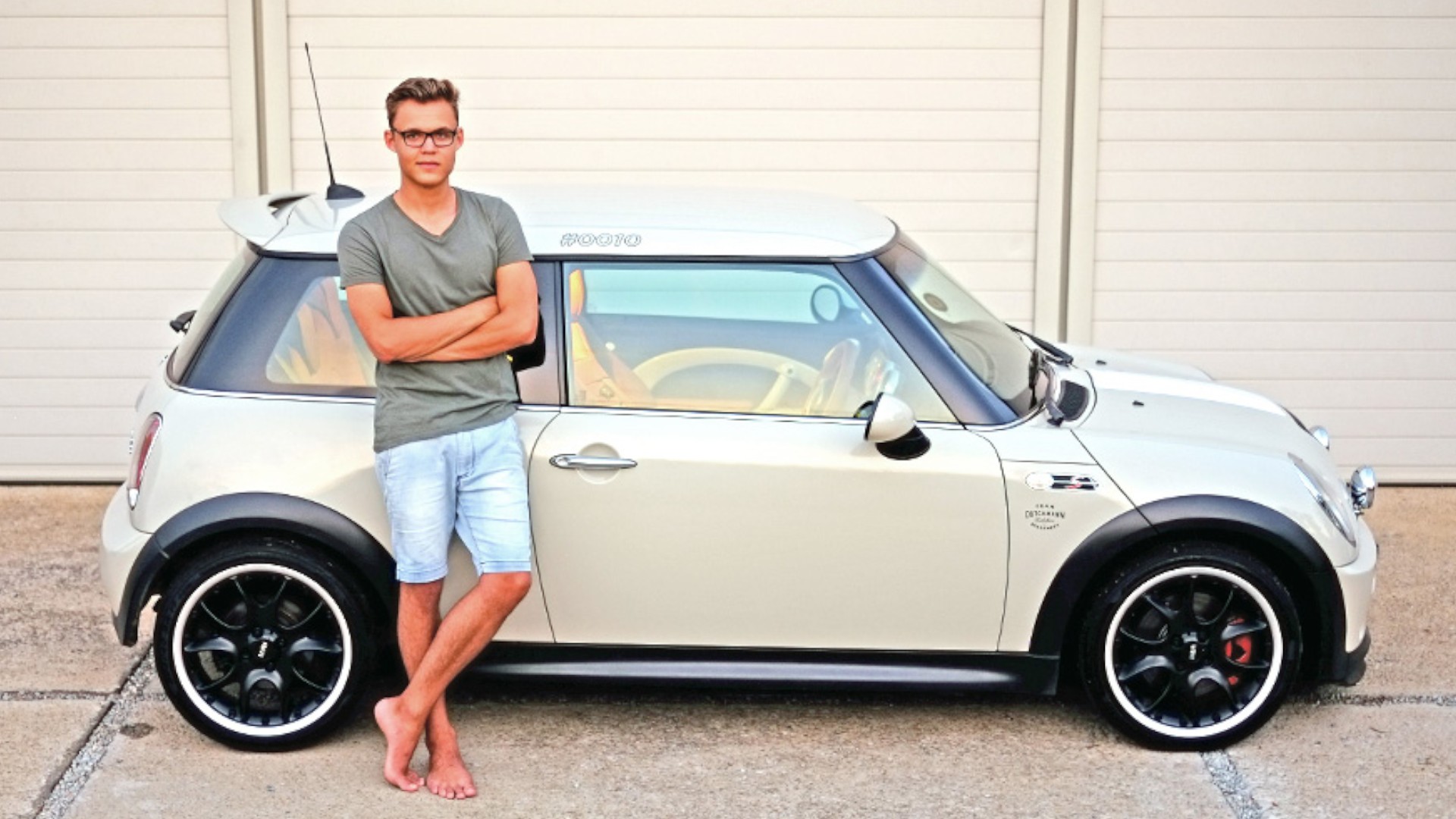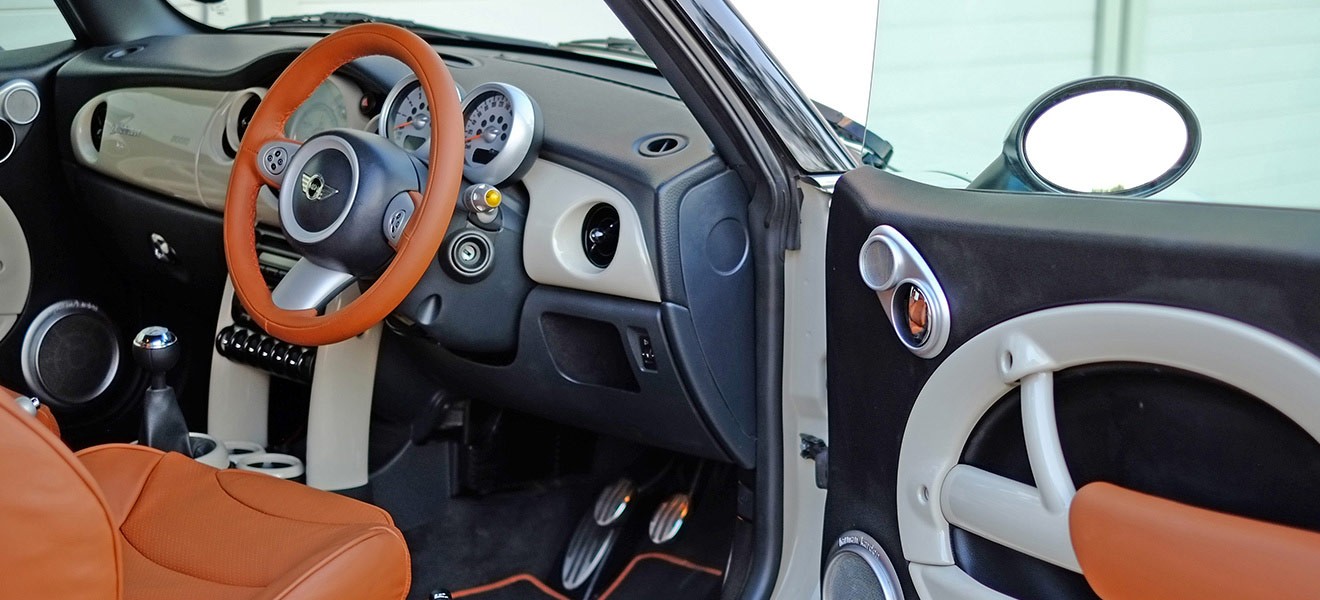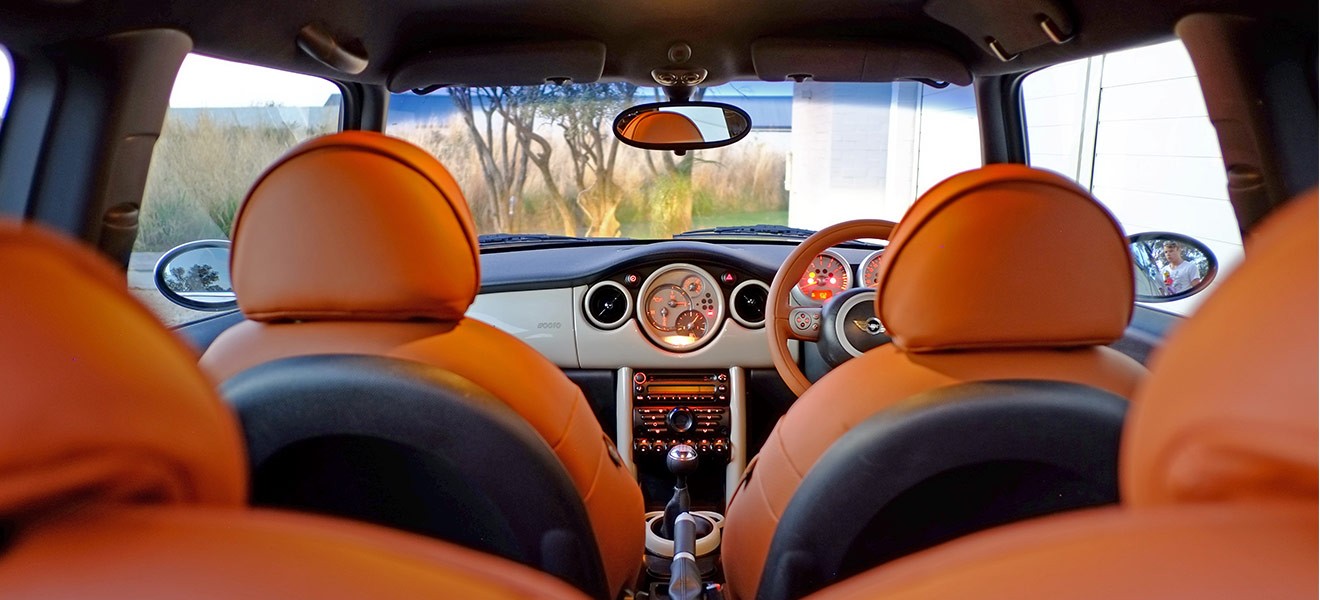Our tool for managing your permission to our use of cookies is temporarily offline. Therefore some functionality is missing.

THE MINI WEEKEND RACER: TRIBUTE TO A MODERN CLASSIC.
Gavin Rooke’s customised 2006 MINI Cooper S John Cooper Works combines unique expression with the brand’s quintessential style
In the first part of this two-part feature, MINI motoring enthusiast and design aficionado Gavin Rooke restored a first-generation MINI Cooper S GP – the ultimate sporting expression of the “new” MINI. He couldn’t resist the temptation to put this gem of a modern classic through its paces, so he strapped on a helmet, put a decal on the windscreen that read “knife to a gunfight”, and raced it at the 2016 Simola Hill Climb in Knysna, the annual mecca of motoring speed and skill.
Despite it being a decade old, Gavin’s GP came far from last, and the experience cemented his deep affection for the “mechanical wonder” of MINI’s first-gen supercharger. Superchargers, unlike the turbochargers in cars today, which use exhaust fumes to drive their turbos, were belt-driven, giving them a rawness and immediacy that Gavin prizes. “It is this fascinating mechanical feature that sucks in air and drives out power,” says Gavin.
The mechanical magic of the supercharger that captured Gavin’s imagination wasn’t limited to the GP. All first-generation MINI Cooper S’s had them, as did the contemporary MINI John Cooper Works, which added extra performance and power.
Gavin runs a design guild called Dutchmann, which specialises in designing and building contemporary products out of iconic, classic designs in many fields, “dipping back into the past and making them contemporary”.
Dutchmann has joined forces with surfboard designer Spider Murphy on a version of a classic 1970s surfboard design, and retired racing cycle frame-builder Duncan MacIntyre on a reboot of one of his 70s frames combined with contemporary materials. One of Dutchmann’s flagship projects involves collaborating with specialist mechanics and craftsmen to create hybrid vintage Porsches with bespoke styling and a combination of modern and classic features. Gavin calls them Weekend Racers.
It was after the Simola Hill climb, that Gavin decided he would create a MINI Weekend Racer. He tracked down a first-generation MINI Cooper S John Cooper Works as a “donor car” and went to work…
Gavin’s approach to customising this MINI was a considered process. “It’s the easiest thing in the world to put after-market brakes on and a big wing on the back and lower the suspension,” says Gavin. “But while that might make the car unique, it also starts to dilute the purity of the original design.”
Gavin wanted his MINI Weekend Racer to walk the fine line between unique expression and a creative engagement with aspects of the brand’s original styling. His customisation intended to emphasise or articulate aspects of the design without departing from a holistic understanding of it.
The first step was the colour. Gavin devised a particular “putty grey”, which might look a bit like MINI’s Pepper White at first glance, but is “fundamentally different”. It’s flatter, with a vintage 60s quality. “This grey is designed to bring out blacks and chromes,” he says. “And it accentuates certain design features, such as the pillars and the way the glass goes from black to chrome into grey.”

The donor car was stripped – the entire cabin taken out and the doors removed. “Every nut and bolt came off, and every nut and bolt went back in again.” Gavin was very particular that there be no panel work. He introduced vintage touches, though, such as carrying the exterior colour through to the dashboard, the dials and the insides of the doors.
The seats and steering wheel were reupholstered in a carefully sourced hand-stitched tan leather – a colour that complements the grey beautifully. Dutchmann collaborated with specialist craftsmen on the bespoke upholstery. “They cut the original patterns,” says Gavin. “They even kept the labels and stitched them back on.” The steering wheel was hand-covered in the same leather. “It’s incredible how it changes the feel of the wheel,” says Gavin. But the buttons on the steering wheel, airbag functionality and so on were faithfully retained.
The rims of the wheels were customised rather than replaced. “They are a specific type of wheel, which came with the [first-generation] John Cooper Works,” says Gavin. He didn’t want to change them. “Wheels have such an important impact on the recognisability of a car,” he adds. “Very seldom does an after-market wheel make a car look better.” Originally, they were silver, but these have been modified, so they are black with a polished lip around the edge – recognisable and in harmony with the rest of the car, but eye-catching and unusual.
Gavin has also added fog lights. “I laboured for a long time trying to decide whether we should have black details or chrome details, but I went for chrome because it has a more nostalgic appeal,” he says. The only thing that purists might not recognise, he ventures, is the “slightly more aggressive bottom lip” that a previous owner had fitted to the bumper. He kept it.
Of course, the air scoop for the supercharger is emphasised in the detailing. “I always wanted to point out the scoop,” says Gavin. “On the GP, there’s a nice big decal that goes around the scoop. I’ve decided that I’d rather have it be a simple black.”
The MINI Weekend Racer has enhancements under the hood, too. The GP was the fastest model of its generation, and Gavin worked with a MINI specialist, Paul Cloete, on a performance upgrade to get it to be “as fast as a GP”. “In fact, it’s slightly faster,” says Gavin. This, despite the fact that, unlike the GP, it still has back seats. (The GPs were omitted to reduce weight.) “Paul knows these cars intimately,” says Gavin, “and he did the MINI-specific work on it. He was an integral part of this process.”

DRIVING IT IS JUST FUN, IT’S UNPRETENTIOUS, AND IT’S HIGH PERFORMANCE.
Paul’s tweaks involved putting in racing cams. “Effectively, you get quite a bit more performance out of the motor with racing cams without in any way damaging it,” says Gavin. He adds: “It also has a larger pully on the supercharger. It’s a classic trick that allows it to push through more air.” The engine has been remapped by these changes, but it’s “nothing crazy”, and no after-market parts except for the racing cam and pully have been added. “This is a very considered balance between performance and durability, and it drives beautifully,” he says. “The engine management system still works the way that it should, so you still get this wonderful balance of a safe, contemporary but nostalgic car.”
The original MINI JCW badging was retained, with the addition of an aluminium Dutchmann badge on the dash and a unique number on the roof to identify this being the 10th Weekend Racer out of the Dutchmann factory – “just like a limited edition GP; a little homage”. The MINI Weekend Racer also has a laser-cut inlay added to the kickplate: a classy finishing touch cementing its new credentials.
It just so happened that Gavin’s son, Liam, was turning 18 around the time the MINI Weekend Racer was completed. He’s “madly in love with MINI”, says Gavin, who surprised him with the beautiful bespoke homage to a unique part of the brand’s motoring heritage. A decade after it first rolled off the production line, the uniquely numbered MINI Weekend Racer has found new life with a new generation. “Driving it is just fun, it’s unpretentious, and it’s high performance,” says Gavin. And there is nothing else in the world quite like it.

